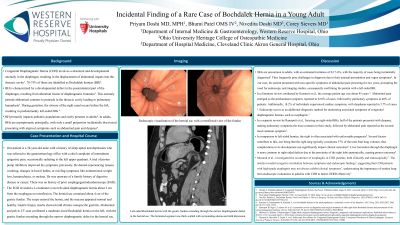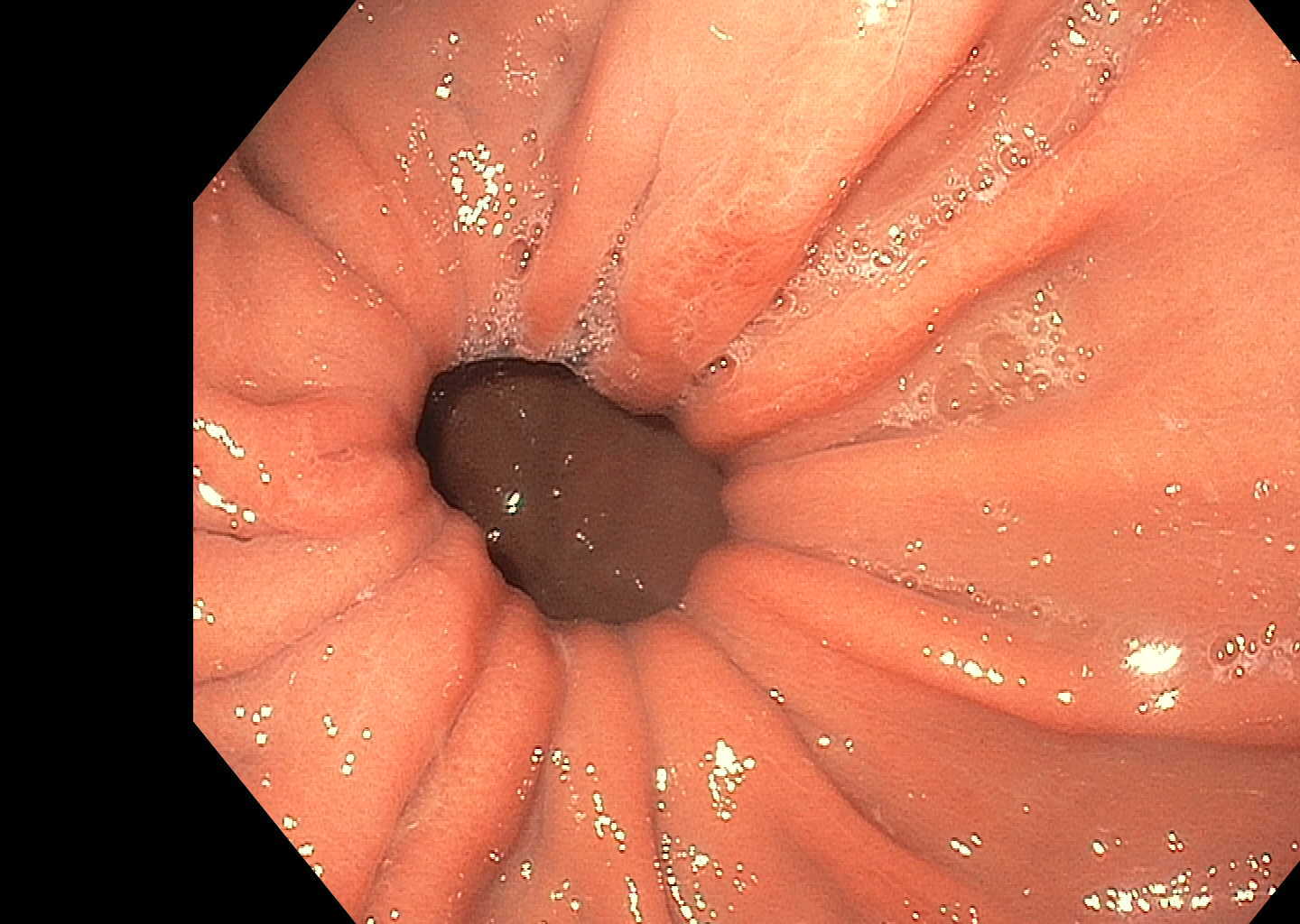Monday Poster Session
Category: General Endoscopy
P2427 - Incidental Finding of a Rare Case of Bochdalek Hernia in a Young Adult
Monday, October 28, 2024
10:30 AM - 4:00 PM ET
Location: Exhibit Hall E

Has Audio
.jpg)
Priyam Doshi, MD, MPH
Western Reserve Hospital
Cuyahoga Falls, OH
Presenting Author(s)
Priyam Doshi, MD, MPH, Bhumi Patel, DO, Corey Sievers, MD
Western Reserve Hospital, Cuyahoga Falls, OH
Introduction: Bochdalek hernia (BH) is characterized by a developmental defect in the posterolateral part of the diaphragm, resulting from abnormal fusion of diaphragmatic foramina. It primarily impacts pediatric population. BH is uncommon in adults with an estimated incidence of 0.17-6%, with majority of cases being incidentally diagnosed.
Case Description/Methods: A 38-year-old male with a history of sleep apnea and depression was referred to the gastroenterology with intermittent epigastric and left upper quadrant pain. PPI improved his symptoms previously. There was no history of prior EGD. On retroflexion, an incidental 2 cm diaphragmatic hernia 3 cm from the esophagus. The hernial sac contained 4 cm of the gastric fundus. The scope entered the hernia, mucosa appeared healthy as in Figure 1. Abdominal CT scan confirmed a moderate-sized Bochdalek hernia. After confirming BH, and ruling out cancerous pathology, the patient was asked to seek consultation with general surgery regarding potential surgical intervention.
Discussion: Bochdalek hernias frequently pose challenges in diagnosis due to their unusual presentation and vague symptoms, hence a heightened clinical suspicion is essential for their diagnosis 4. In a literature review conducted by Katsaros et al., the average patient age was about 45 years 4. In the studies, abdominal pain emerged as the predominant symptom, reported in 62.0% of cases, followed by pulmonary symptoms in 40% of patients. Additionally, 18.2% of individuals experienced cardiac symptoms, with dysphasia reported in 5.7% of cases 4. In comparison to left-sided hernias, those on the right are often associated with unfavorable prognosis 6. CT scans are found to exhibit sensitivities of 78% for left-sided hernias and 50% for those on the right side. Endoscopy serves as an additional diagnostic method for monitoring associated symptoms of congenital diaphragmatic hernias, such as esophagitis 7. Morandi et al., investigated the occurrence of esophagitis in CDH patients, both clinically and endoscopically7, the results revealed a negative correlation between symptoms and endoscopic findings7. This underscores the importance of routine long-term endoscopic evaluations in patients with CDH to detect GERD effectively7. Surgical intervention Surgical approach has been commonly performed to correct the defect. Considering the limited research on BHs, it is imperative to present our case to contribute to the existing literature and increase awareness for potential interventional endoscopies.

Disclosures:
Priyam Doshi, MD, MPH, Bhumi Patel, DO, Corey Sievers, MD. P2427 - Incidental Finding of a Rare Case of Bochdalek Hernia in a Young Adult, ACG 2024 Annual Scientific Meeting Abstracts. Philadelphia, PA: American College of Gastroenterology.
Western Reserve Hospital, Cuyahoga Falls, OH
Introduction: Bochdalek hernia (BH) is characterized by a developmental defect in the posterolateral part of the diaphragm, resulting from abnormal fusion of diaphragmatic foramina. It primarily impacts pediatric population. BH is uncommon in adults with an estimated incidence of 0.17-6%, with majority of cases being incidentally diagnosed.
Case Description/Methods: A 38-year-old male with a history of sleep apnea and depression was referred to the gastroenterology with intermittent epigastric and left upper quadrant pain. PPI improved his symptoms previously. There was no history of prior EGD. On retroflexion, an incidental 2 cm diaphragmatic hernia 3 cm from the esophagus. The hernial sac contained 4 cm of the gastric fundus. The scope entered the hernia, mucosa appeared healthy as in Figure 1. Abdominal CT scan confirmed a moderate-sized Bochdalek hernia. After confirming BH, and ruling out cancerous pathology, the patient was asked to seek consultation with general surgery regarding potential surgical intervention.
Discussion: Bochdalek hernias frequently pose challenges in diagnosis due to their unusual presentation and vague symptoms, hence a heightened clinical suspicion is essential for their diagnosis 4. In a literature review conducted by Katsaros et al., the average patient age was about 45 years 4. In the studies, abdominal pain emerged as the predominant symptom, reported in 62.0% of cases, followed by pulmonary symptoms in 40% of patients. Additionally, 18.2% of individuals experienced cardiac symptoms, with dysphasia reported in 5.7% of cases 4. In comparison to left-sided hernias, those on the right are often associated with unfavorable prognosis 6. CT scans are found to exhibit sensitivities of 78% for left-sided hernias and 50% for those on the right side. Endoscopy serves as an additional diagnostic method for monitoring associated symptoms of congenital diaphragmatic hernias, such as esophagitis 7. Morandi et al., investigated the occurrence of esophagitis in CDH patients, both clinically and endoscopically7, the results revealed a negative correlation between symptoms and endoscopic findings7. This underscores the importance of routine long-term endoscopic evaluations in patients with CDH to detect GERD effectively7. Surgical intervention Surgical approach has been commonly performed to correct the defect. Considering the limited research on BHs, it is imperative to present our case to contribute to the existing literature and increase awareness for potential interventional endoscopies.

Figure: Endoscopic visualization of the hernial sac
Disclosures:
Priyam Doshi indicated no relevant financial relationships.
Bhumi Patel indicated no relevant financial relationships.
Corey Sievers indicated no relevant financial relationships.
Priyam Doshi, MD, MPH, Bhumi Patel, DO, Corey Sievers, MD. P2427 - Incidental Finding of a Rare Case of Bochdalek Hernia in a Young Adult, ACG 2024 Annual Scientific Meeting Abstracts. Philadelphia, PA: American College of Gastroenterology.
